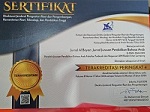Technique and Quality Translation of Idhafi in The Matan Hadits of Arba'in al-Nawawi
Abstract
Keywords
Full Text:
PDFReferences
Akbari, Monireh. "Strategies for Translating Idioms," Journal of Academic and Applied Studies (Special Issue on Applied Linguistics), 3, no. 8 (2013): 32–14.
Akmaliyah, A. “Model Dan Teknik Penerjemahan Kalimat Bahasa Arab Ke Dalam Bahasa Indonesia,” Al-Tsaqafa: Jurnal Ilmiah Peradaban Islam, 13 (01) (2016): 125–34.
Al-Munawwir, Ahmad Warson, ‘Kamus Al-Munawwir Arab-Indonesia Terlengkap’, Pustaka Progressif (Yogyakarta, 1997)
Alsrhid, Arif Mohammed Mufleh, ‘Difficulties Face by Foreign Students in Learning Arabic Language Programs for Non-Native Speakers (Evaluation Study)’, Learning, 4.2 (2013), 160–70
Baharudin, Harun. "Strategi dan Teknik Terjemahan Novel Arab dalam Kalangan Pelajar Universiti (Arabic Novel Translation Strategies and Techniques used among University Students)." GEMA Online® Journal of Language Studies 17.4 (2017): 225-243, http://dx.doi.org/10.17576/gema-2017-1704-15.
Buska, Wahyudi, Yogia Prihartini, and Nur Hasnah, ‘Analysis of Students’ Arabic Proficiency for Vocabulary Mastery in State Islamic Junior High School in Muaro Jambi’, INNOVATIO: Journal for Religious Innovation Studies, 18.1 (2018), 51–62 .
Carreres, Ángeles, and María Noriega-Sánchez. "Translation in Language Teaching: Insights from Professional Translator Training," The Language Learning Journal, 39, no. 3 (2011): 281–97.
Esposito, Noreen. "From meaning to meaning: The influence of translation techniques on non-English focus group research." Qualitative health research 11, no. 4 (2001): 568-579.
Gouadec, Daniel. Translation as a Profession. Vol. 73. Amsterdam: John Benjamins Publishing, 2007.
Hendrastuti, Retno. "Kajian Terjemahan Metafora yang Menunjukkan Sikap dalam Buku Motivasi The Secret." TransLing Journal: Translation and Linguistics 1, No. 1 (2013).
Holes, Clive, Modern Arabic: Structures, Functions, and Varieties (Washington: Georgetown University Press, 2004)
Huehnergard, John, ‘Arabic in Its Semitic Context’, in Arabic in Context (Leiden: Brill, 2017), pp. 3–34 .
Kobyakova, Iryna and Svitlana ShvacErtnohko “Teaching Translation: Objectives and Methods.” Advanced Education (2016): 9-13, https://doi.org/10.20535/2410-8286.61029.
Lewis, Bernard, Semites and Anti-Semites: An Inquiry into Conflict and Prejudice (New York and London: WW Norton & Company, 1999)
Majid, Latifah Abdul, and Nurullah Kurt. "Bahr Al-Madhi: Significant Hadith Text Sciences for Malay Muslims as a Tool for Political Teaching during Twentieh Century," Mediterranean Journal of Social Sciences, 5, no. 20 (2014): 2249.
Mayer, Isabella. "Qualitative Research with a Focus on Qualitative Data Analysis," International Journal of Sales, Retailing & Marketing, 4, no. 9 (2015): 53–67.
Molina, L, Albir, A.H. “Translation Techniques Revisited: A Dynamic and Functionalist Approach.” Les Presses de l’Université de Montréal, Journal des traducteurs, 47, no. 4 (2002): 498-512., id.erudit.org/iderudit/008033ar https://doi.org/10.7202/008033ar.
Murtafi, Anshoffy, Nababan Nababan, and Djatmika Djatmika. "Analisis Terjemahan Gaya Bahasa Repetisi Dalam Novel A Thousand Splendid Suns, Teknik Dan Kualitasnya (Kajian Penerjemahan Dengan Pendekatan Stilistika)." PRASASTI: Journal of Linguistics 2.1 (2017): 1-20.
Nababan, Mangatur, ‘Aspek Genetik, Objektif, Dan Afektif Dalam Penelitian Penerjemahan’, Linguistika, 14.26 (2007), 15–23
———, ‘Kecenderungan Baru Dalam Penerjemahan’, Englonesian: Jurnal Ilmiah Linguistik Dan Sastra, 2.1 (2006), 68–73
Neubert, Albrecht, ‘Competence in Language, in Languages, and in Translation’, Benjamins Translation Library, 38 (2000), 3–18
Olk, Harald Martin, ‘Cultural References in Translation: A Framework for Quantitative Translation Analysis’, Perspectives, 21.3 (2013), 344–57
Rahmawati, Anindia Ayu, Nababan Nababan, and Riyadi Santosa, ‘Kajian Teknik Penerjemahan Dan Kualitas Terjemahan Ungkapan Yang Mengandung Seksisme Dalam Novel The Mistress’s Revenge Dan Novel The 19th Wife’, Prasasti: Journal of Linguistics, 1.2 (2016), 249–70
Rohana, Yogi, Riyadi Santosa, and Djatmika Djatmika, ‘Gaya Bahasa, Teknik Penerjemahan, Dan Kualitas Terjemahan Dalam Dongeng Disney Dwibahasa Berjudul Cinderella: My Bedtime Story Dan Tinkerbell And The Great Fairy Rescue.’, PRASASTI: Journal of Linguistics, 2.1, 150–66
Torop, Peeter, ‘Translation as Translating as Culture’, Σημειωτκή-Sign Systems Studies, 30.2 (2002), 593–605
Yoyo, Yoyo, and Abdul Mukhlis, ‘Historiography of the Arabic Grammar in Europe: The Legacy of Wright’s Arabic Grammar’, in First International Conference on Progressive Civil Society (ICONPROCS 2019) (Atlantis Press, 2019), pp. 212–15
Yoyo, Yoyo, Abdul Mukhlis, Thonthowi Thonthowi, and Ferawati Ferawati, ‘High Variety Vs Low Variety Culture in the Arabic Language: The Tensions between Fushā and ‘Âmiyya in the Contemporary Arab World’, Arabi: Journal of Arabic Studies,5.1(2020),25–32 .
DOI: http://dx.doi.org/10.24042/albayan.v12i2.5882
Refbacks
- There are currently no refbacks.
Copyright (c) 2020 Jurnal Al Bayan: Jurnal Jurusan Pendidikan Bahasa Arab
License URL: https://creativecommons.org/licenses/by-sa/4.0
Editorial Office:
Jurnal Al Bayan: Jurnal Jurusan Pendidikan Bahasa Arab, Arabic Education Study Program, Faculty of Education and Teachers Training, Unversitas Islam Negeri Raden Intan Lampung
Jl. Endro Suratmin 1 Sukarame, Bandar Lampung 35131-Indonesia
e-mail: jurnalalbayan@radenintan.ac.id
http://ejournal.radenintan.ac.id/index.php/albayan/index
Jurnal Al Bayan: Jurnal Jurusan Pendidikan Bahasa Arab is licensed under a Creative Commons Attribution-ShareAlike 4.0 International License. p-ISSN 2086-9282 | e-ISSN 2549-1229









